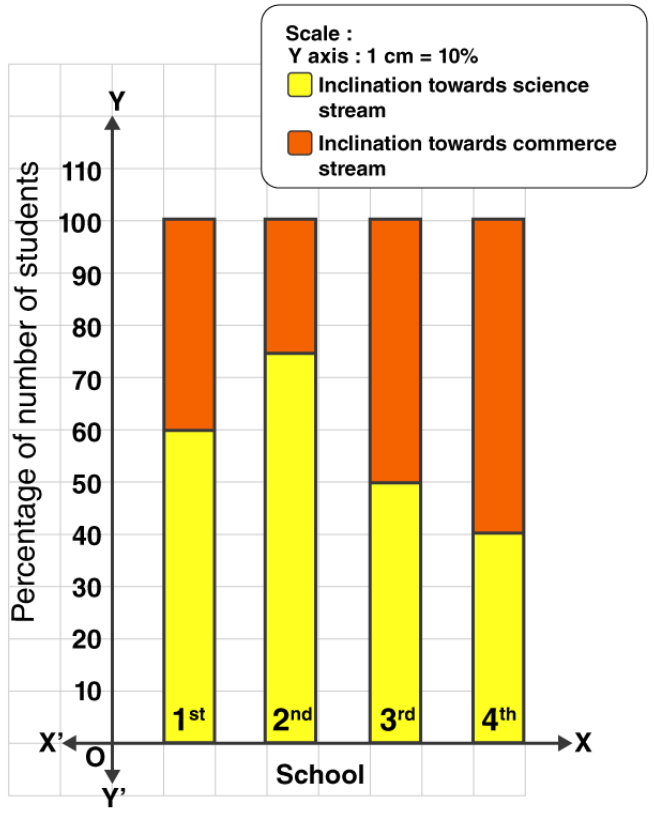Need help? We're here to assist you!
Thank You for Enquiry, we will contact you soon!
Close
The Class 8 is an important year in a student’s life and Maharashtra State Board Maths is one of the subjects that require dedication, hard work, and practice. It’s a subject where you can score well if you are well-versed with the concepts, remember the important formulas and solving methods, and have done an ample amount of practice. Worry not! Home Revise is here to make your Class 8 journey even easier. It’s essential for students to have the right study material and notes to prepare for their board examinations, and through Home Revise, you can cover all the fundamental topics in the subject and the complete Maharashtra State Board Class 8 Maths Book syllabus.

Practice Set 11.1 Page No: 69
1. The following table shows the number of saplings planted by 30 students. Fill in the boxes and find the average number of saplings planted by each student.

Solution:
| No. of saplings (Scores) xi | No. of students (Frequency) fi | fi × xi |
| 1 | 4 | 4 |
| 2 | 6 | 12 |
| 3 | 12 | 36 |
| 4 | 8 | 32 |
| N = 30 | Ʃ fi xi = 84 |
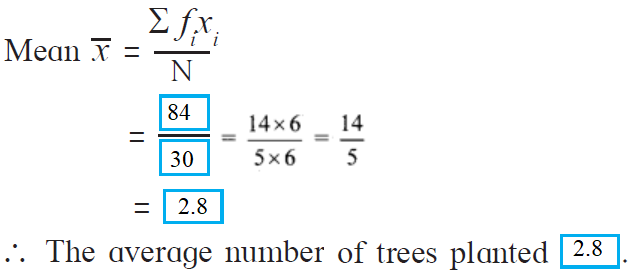
2. The following table shows the electricity (in units) used by 25 families of Eklara village in a month of May. Complete the table and answer the following questions.
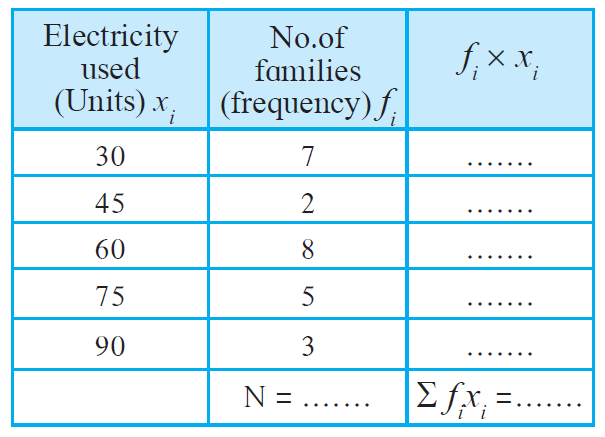
(1) How many families use 45 units electricity?
(2) State the score, the frequency of which is 5.
(3) Find N, and Ʃ fi xi
(4) Find the mean of electricity used by each family in the month of May.
Solution:
| Electricity used (Units) xi | No. of families (Frequency) fi | fi × xi |
| 30 | 7 | 210 |
| 45 | 2 | 90 |
| 60 | 8 | 480 |
| 75 | 5 | 375 |
| 90 | 3 | 270 |
| N = 25 | Ʃ fi xi = 1425 |
(1) 2 families used 45 units od electricity.
(2) The score for which the frequency is 5 is 75.
(3) N = 25 and Ʃ fi xi = 1425
(4) The mean of electricity used by each family in the month of May is given by:
Mean () = Ʃ fi xi / N
= 1425 / 25
= 57
Thus, the mean of electricity used by each family in the month of May is 57 units.
3. The number of members in the 40 families in Bhilar are as follows:
1, 6, 5, 4, 3, 2, 7, 2, 3, 4, 5, 6, 4, 6, 2, 3, 2, 1, 4, 5, 6, 7, 3, 4, 5, 2, 4, 3, 2, 3, 5, 5, 4, 6, 2, 3, 5, 6, 4, 2. Prepare a frequency table and find the mean of members of 40 families.
Solution:
| Number of members | Number of families (fi ) | fi xi |
| 1 | 2 | 2 |
| 2 | 8 | 16 |
| 3 | 7 | 21 |
| 4 | 8 | 32 |
| 5 | 7 | 35 |
| 6 | 6 | 36 |
| 7 | 2 | 14 |
| N = 40 | Ʃ fi xi = 156 |
Now,
Mean = Ʃ fi xi / N = 156/ 40 = 3.9
Thus, the mean of members of 40 families is 3.9.
4. The number of Science and Mathematics projects submitted by Model high school, Nandpur in last 20 years at the state level science exhibition is : 2, 3, 4, 1, 2, 3, 1, 5, 4, 2, 3, 1, 3, 5, 4, 3, 2, 2, 3, 2. Prepare a frequency table and find the mean of the data.
Solution:
| Number of projects (xi ) | Frequency (fi ) | fi xi |
| 1 | 3 | 3 |
| 2 | 6 | 12 |
| 3 | 6 | 18 |
| 4 | 3 | 12 |
| 5 | 2 | 10 |
| N = 20 | Ʃ fi xi = 55 |
Now,
Mean = Ʃ fi xi / N = 55/ 20 = 2.75
Thus, the mean of the data = 2.75
Practice Set 11.2 Page No: 71
1.
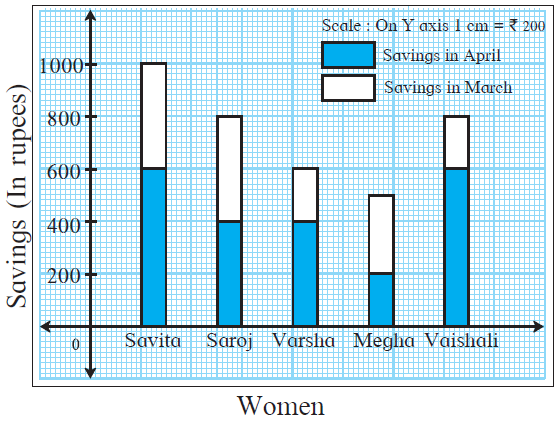
(1) State the type of the graph.
(2) How much is the savings of Vaishali in the month of April?
(3) How much is the total of savings of Saroj in the months March and April?
(4) How much more is the total savings of Savita than the total savings of Megha?
(5) Whose savings in the month of April is the least?
Solution:
(1) The given is a bar graph.
(2) The savings of Vaishali in the month of April is Rs 600.
(3) The total savings of Saroj in the months March and April is Rs 800.
(4) From the table it’s seen that, the total savings of Savita = Rs 1000
And, the total savings of Megha = Rs 500
So, the difference in their savings = 1000 − 500 = 500
Hence, the total savings of Savita is Rs 500 more than the total savings of Megha.
(5) The savings of Megha in the month of April is the least i.e. Rs 200.
2. The number of boys and girls, in std 5 to std 8 in a Z.P. school is given in the table. Draw a subdivided bar graph to show the data.
(Scale: On Y axis, 1cm = 10 students)

Solution:
Given data,
| Standard | 5th | 6th | 7th | 8th |
| Boys | 34 | 26 | 21 | 25 |
| Girls | 17 | 14 | 14 | 20 |
| Total | 51 | 40 | 35 | 45 |
Now,
The subdivided bar graph of the given data is as follows:
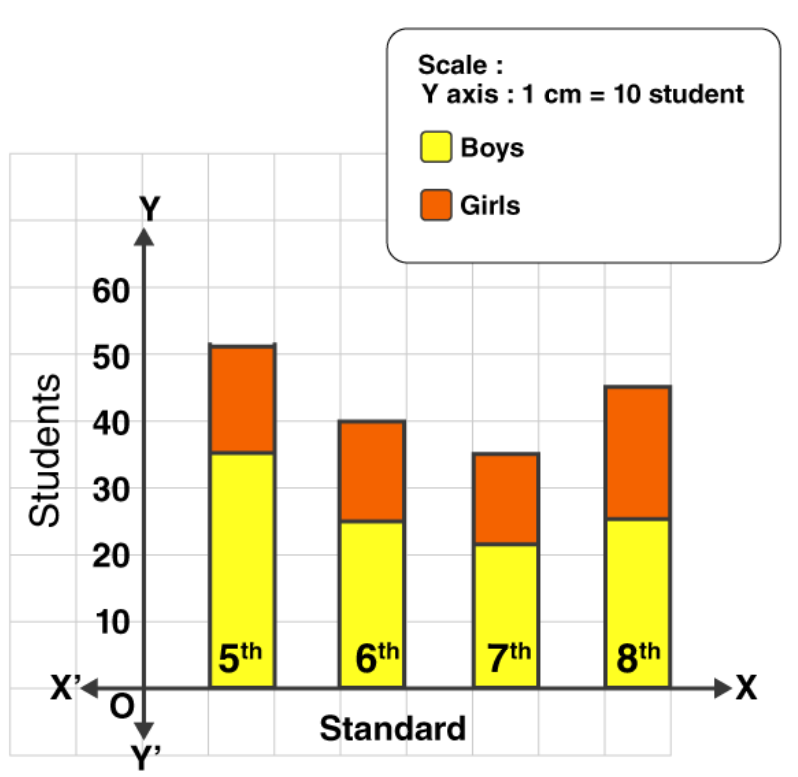
3. In the following table number of trees planted in the year 2016 and 2017 in four towns is given. Show the data with the help of subdivided bar graph.

Solution:
Given data,
| Year\Town | Karjat | Wadgoan | Shivapur | Khandala |
| 2016 | 150 | 250 | 200 | 100 |
| 2017 | 200 | 300 | 250 | 150 |
| Total | 350 | 550 | 450 | 250 |
Now,
The subdivided bar graph of the given data is as follows:
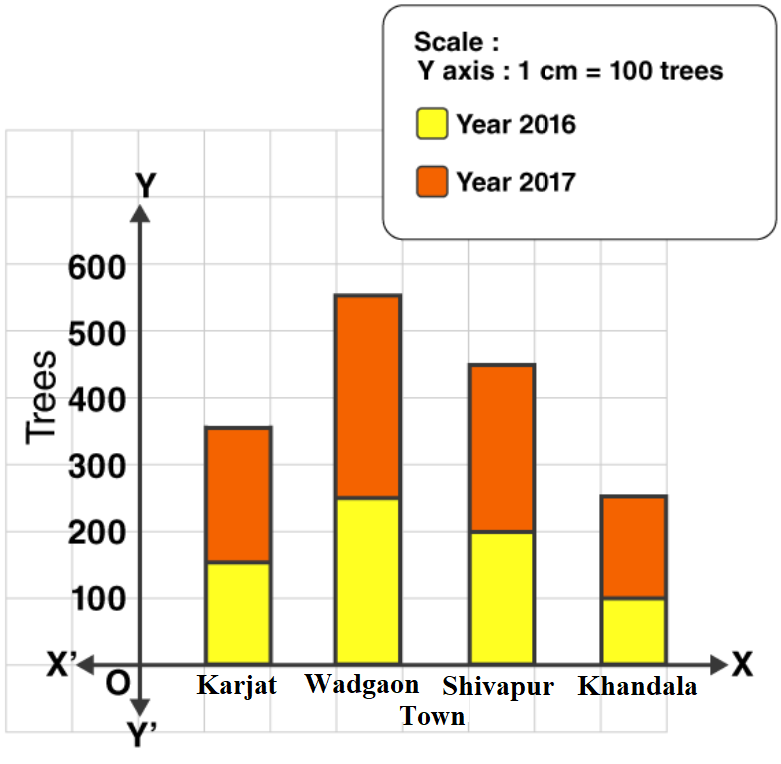
4. In the following table, data of the transport means used by students in 8th standard for commutation between home and school is given. Draw a subdivided bar diagram to show the data.
(Scale: On Y axis: 1 cm = 500 students)

Solution:
Given data,
| Town → | Paithan | Yeola | Shahapur |
| Mean of communication ↓ | |||
| Cycle | 3250 | 1500 | 1250 |
| Bus and Auto | 750 | 500 | 500 |
| On foot | 1000 | 1000 | 500 |
| Total | 5000 | 3000 | 2250 |
Now,
The subdivided bar diagram of the given data is as follows

Practice Set 11.3 Page No: 73
1. Show the following information by a percentage bar graph.

Solution:
Given data,
| Division of standard 8 | A | B | C | D |
| Number of students securing grade A | 45 | 33 | 10 | 15 |
| Total number of students | 60 | 55 | 40 | 75 |
| Percentage of students securing grade A | (45/60) x 100 = 75% | (33/55) x 100 = 60% | (10/40) x 100 = 25% | (15/75) x 100 = 20% |
Now, the percentage bar graph is:
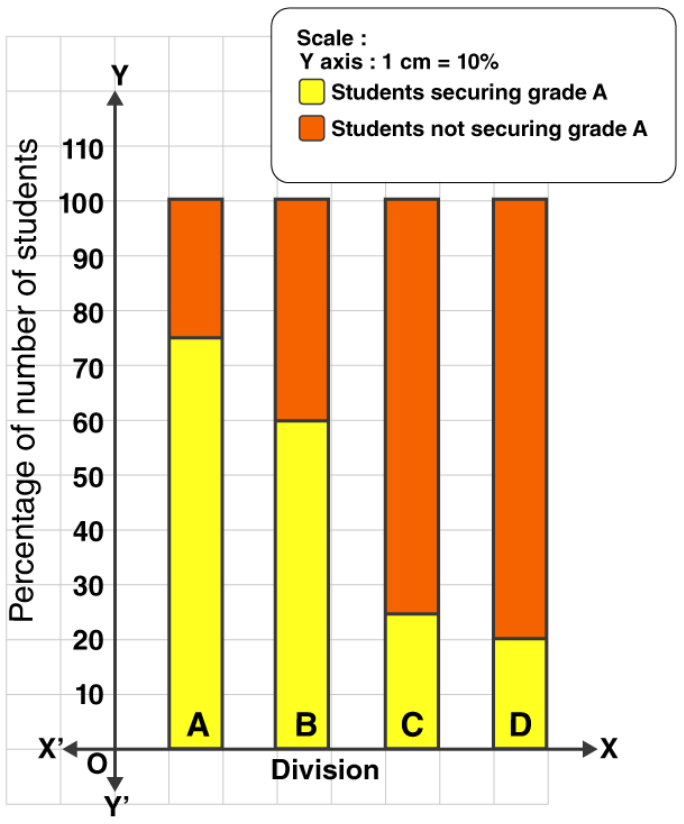
2.
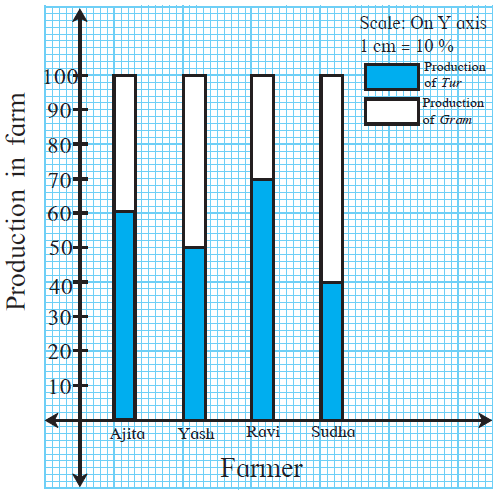
(1) State the type of the bar graph.
(2) How much percent is the Tur production to total production in Ajita’s farm?
(3) Compare the production of Gram in the farms of Yash and Ravi and state whose percentage of production is more and by how much?
(4) Whose percentage production of Tur is the least?
(5) State production percentages of Tur and gram in Sudha’s farm.
Solution:
From the given graph, it can be inferred that:
(1) The given graph is a percentage bar graph.
(2) Percent of tur production to the total production in Ajita’s farm is 60%.
(3) Production of Gram in the farm of Yash = 50%
And, the production of Gram in the farm of Ravi = 30%
So, the difference in the production = 50% – 30% =20%
Thus, Yash’s production of Gram is more and by 20%.
(4) The least production percentage of Tur is of Sudha.
(5) The production percentages of Tur and Gram in Sudha’s farm are 40% and 60% respectively.
3. The following data is collected in a survey of some students of 10th standard from some schools. Draw the percentage bar graph of the data.

Solution:
Given data,
| School | 1st | 2nd | 3rd | 4th |
| Inclination towards science stream | 90 | 60 | 25 | 16 |
| Inclination towards commerce stream | 60 | 20 | 25 | 24 |
| Total | 150 | 80 | 50 | 40 |
| Percentage of students having inclination towards science stream | (90/150) x 100 = 60% | (60/80) x 100 = 75% | (25/50) x 100 = 50% | (16/40) x 100 = 40% |
| Percentage of students having inclination towards commerce stream | (60/150) x 100 = 40% | (20/80) x 100 = 25% | (25/50) x 100 = 50% | (24/40) x 100 = 60% |
The percentage bar graph of the given data is as follows:
